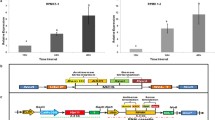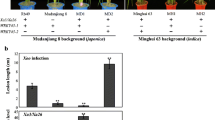Abstract
A plant expression vector harboring four antifungal genes was delivered into the embryogenic calli of ‘9311’, an indica restorer line of Super Hybrid Rice, via modified biolistic particle bombardment. Southern blot analysis indicated that in the regenerated hygromycin-resistant plants, all the four antifungal genes, including RCH10, RAC22, β-Glu and B-RIP, were integrated into the genome of ‘9311’, co-transmitted altogether with the marker gene hpt in a Mendelian pattern. Some transgenic R1 and R2 progenies, with all transgenes displaying a normal expression level in the Northern blot analysis, showed high resistance to Magnaporthe grisea when tested in the typical blast nurseries located in Yanxi and Sanya respectively. Furthermore, transgenic F1 plants, resulting from a cross of R2 homozygous lines with high resistance to rice blast with the non-transgenic male sterile line Peiai 64S, showed not only high resistance to M. grisea but also enhanced resistance to rice false smut (a disease caused by Ustilaginoidea virens) and rice kernel smut (another disease caused by Tilletia barclayana).
Similar content being viewed by others
References
Yuan L P, Xin Y Y. Light of hope: Super Hybrid Rice. World Agr (in Chinese), 2001, 10(10): 46
Yang C X, Xiang B H, Zhang Q M, et al. Cultural techniques of achieving a yield of 12.26 t/hm2 in the demonstrative production of two-line Super Hybrid Rice under an area over 6.7 hectares. Hybrid Rice (in Chinese), 2003, 18(2): 42–44
Wang Q, Lu C M, Zhang Q D, et al. Characterization of photosynthesis, photoinhibition and the activities of C4 pathway enzymes in a superhigh-yield rice, Liangyoupeijiu, Sci China Ser C-Life Sci, 2002, 45(5): 468–476
Lu K Y, Wu H M, Lu B L. Identification of the elite medium rice variety Liangyoupeijiu and Yangdao 6. Hubei Agr Sci (in Chinese), 2001, (3): 9–12
Dong X H, Tian X Z, Wang L, et al. The occurrence rule and its IPM technique of the diseases and pests of two-line hybrid medium indica rice-Liangyou Peijiu. J Anhui Agr Sci (in Chinese), 2001, 29(3): 342–344
Ma Z, He S L, Jin K M, et al. The reason of the occurrence of rice kernel smut in the hybrid seed production of Liangyou Peijiu and its prevention and cure. J Xinyang Agr College (in Chinese), 2001, 11(2): 13–15
Jach G, Gornhardt B, Mundy J, et al. Enhanced quantitative resistance against fungal disease by combinatorial expression of different barley antifungal proteins in transgenic tobacco. Plant J, 1995, 8(1): 97–109
Feng D R, Wei J W, Xu X P, et al. Introduction of multiple antifungal protein genes into rice and preliminary study on resistance to Pyricularia oryzae of transgenic rice. Acta Sci Nat Univ Sunyatseni (in Chinese), 1999, 38(4): 62–66
Feng D R, Xu X P, Fan Q, et al. Rice plants of multiple transgenes for resistance to rice blast and sheath blight diseases. Acta Agron Sin (in Chinese), 2001, 27(3): 293–301
Feng D R, Xu X P, Qiu G H, et al. Inheritance and expression of multiple disease and insect resistance genes in transgenic rice. Chin Sci Bull, 2001, 46: 101–106
Li M, Qiu G H, Xu X P, et al. The construction of plant expression vector containing multi-antifungal genes. Acta Sci Nat Univ Sunyatseni (in Chinese), 1999, 38(5): 67–71
Xu X P, Wei J W, Fan Y L, et al. Fertile transgenic indica rice from microprojectile bombardment of embryogenic callus. Acta Genet Sin (in Chinese), 1999, 26(3): 219–227
Doyle J J, Doyle J L. Isolation of plant DNA from fresh tissue. Focus, 1990, 12: 13–15
Zhu H C, Xu X P, Li B J. A simple, rapid method of Southern blot analysis. Acta Sci Nat Univ Sunyatseni (in Chinese), 2004, 43(4): 128–130
Xiao F H, Luo H R, He Z N, et al. Identification and application of the multiple durable resistance of the dryland rice. Hunan Agr Sci (in Chinese), 2001, (5): 39–41
International Rice Research Institute. Standard Evaluation System for Rice (SES). Los Banos: IRRI, 2002, 14–18
Zhu Q, Lamb C J. Isolation and characterization of a rice gene encoding a basic chitinase. Mol Gen Genet, 1991, 226: 289–296
Li B J, Zhu H C. On the prospects of applying the Multi-gene Transformation Strategy to modify the inheritance of organisms I. The gene resources and technical platform for multi-gene transformation. Acta Sci Nat Univ Sunyatseni (in Chinese), 2004, 43(6): 11–15
Li B J, Zhu H C. On the prospects of applying the Multi-gene Transformation Strategy (MTS) to modify the inheritance of organisms II. General principles, possible problems and prospects of the MTS. Acta Sci Nat Univ Sunyatseni (in Chinese), 2005, 44(4): 79–83
McDowell J M, Woffenden B J. Plant disease resistance genes: recent insights and potential applications. Trends in biotechnol, 2003, 21(4): 178–183
Shah D M. Genetic engineering for fungal and bacterial diseases. Curr Opin Biotechnol, 1997, 8(2): 208–214
Punja Z K. Genetic engineering of plants to enhance resistance to fungal pathogens—A review of progress and future prospects. Can J Plant Pathol, 2001, 23: 216–235
Ming X T, Wang L J, An C C, et al. Resistance to rice blast (Pyricularia oryzae) caused by the expression of trichosanthin gene in transgenic rice plants transferred through agrobacterium method. Chin Sci Bull, 2000, 19: 1774–1778
Shan L B, Jia X. Ribosome inactivating protein and its application in plant anti-fungal disease genetic engineering. Progr Biotechnol (in Chinese), 2000, 20(6): 74–78
Bai H S, Zhan C Y, Wang B H, et al. Medium indica rice variety Yangdao 6 and its application in hybrid rice breeding. Hybrid Rice (in Chinese), 2001, 16(6): 13–15
Author information
Authors and Affiliations
Corresponding authors
Additional information
Supported by the National High-Tech Research and Development Project (863) (Grant No. 101-01-02-02), National Specific Program for Research and Industrialization of Transgenic Plant (Grant Nos. J00-A-009 and J99-B-012), and Science & Technology Project of Guangdong Province (Grant No. B201)
Rights and permissions
About this article
Cite this article
Zhu, H., Xu, X., Xiao, G. et al. Enhancing disease resistances of Super Hybrid Rice with four antifungal genes. SCI CHINA SER C 50, 31–39 (2007). https://doi.org/10.1007/s11427-007-0001-9
Received:
Accepted:
Issue Date:
DOI: https://doi.org/10.1007/s11427-007-0001-9




